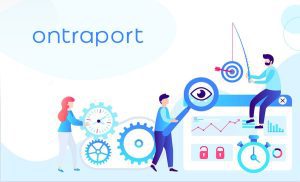Revenue Operations, or RevOps, as it is commonly known, is the new engine room in business and for business owners. It is an umbrella term for a new way of thinking about your company structure and a strategic approach to marketing, sales, and customer service.
The power of RevOps is its ability to generate revenue through accurate data collection, synthesis, and dissemination. However, many of its processes are time-consuming and usually labor-intensive. Business process automation and other automation tools help to alleviate this burden, allowing you and other team members to focus on growth.
So, if you are looking to start or take your RevOps to the automated level, you’ll find all you need in this article.
First, let’s discuss RevOps a little further.
What is RevOps?
Revenue Operations is what drives a business’ sales strategies, funnel approaches, pricing models, cost assessments, and decisions, with the goal of optimizing its revenue generation potential. Its primary function is to integrate and align all departments involved in the typical customer lifecycle, i.e., all processes from lead generation to sales and customer success.
Businesses design their RevOps by creating a workflow between the marketing, sales, and customer service teams to improve collaboration and efficiency using shared data and technology.
RevOps begins when a potential customer sees your advertisement and considers purchasing your product (marketing), continues when the customer makes a purchase (sales), and ends with satisfaction and retention (customer service).
You want to optimize your marketing strategies so that they generate the most qualified leads possible. Then, you ensure that as many leads as possible are converted to paying customers and that every customer is satisfied after purchasing —all of which leads to increased revenue generation and faster growth.
Cool right?
Let’s discuss why automation makes RevOps Processes easier.

Benefits of Automating Revenue Operations
- Unification of Processes Across Departments
Revenue operation automation helps to unify operations and processes across multiple departments, including sales, marketing, brand, accounting, creative, product, and customer management. Using Marketing Automation, Project Management, and CRM software tools you’ll drive collaboration across all departments and ensure that everyone is working towards a common goal. - Improved Internal Operations
Synchronizing processes across all departments facilitates better communication and collaboration. This often results in an improved overall efficiency of a company’s internal operations. Introducing automation tools and setting up workflows for all teams will improve these internal processes, with easy reporting and assignment review. - Increased Customer Satisfaction and Retention
Through a combination of business process automation tools, your RevOps will improve customers’ experience with the brand. All departments will be present at every touch point in your customers’ journey and you’ll see where you need adjustments and optimizations. A key example is using similar language in all parts of the business, from the marketing channels, online communities, and sales funnels, to their first purchase, customer onboarding, and post-purchase support. - Increased Revenue Generation
Properly automated Revenue Operations will lead to more leads, higher conversion rates, and in the long run, an increase in revenue and profits for your business. When operations run smoothly and customers have a great experience, it increases customers’ trust and willingness to do more business with your company. - Increased Overall Efficiency
Automation of revenue operations helps to increase productivity, save time, and improve the overall performance of all teams involved in a project. Business process automation allows operations to be automatically carried out in sequence while identifying and correcting errors in the workflow, leading to greater efficiency. - Reduced Human Dependency
Using automation tools in your revenue operations reduces the need for more human hands in the whole process. In place of having employees execute simple, repetitive, and time-consuming tasks, you can have them automated. Reducing human involvement also means you’ll have fewer errors while task execution will also be faster.

4 RevOps Processes to Automate
- Sales Process
The sales process is very important to revenue generation. Automating as much as possible, in a personalized way, helps to ensure that you reach as many prospects as possible, follow up with leads, and create a highly personalized conversion funnel. - Customer Service
Business process automation tools such as CRM, ensure that your customers are taken care of at all times using omnichannel communication strategies. It automatically sends reminders to customers and notifies them about new content, products, and services, and initiates support. Automating your customer service allows customers to raise tickets seamlessly through a CRM. You get to track their high and low points and have a clear view of where and why things went wrong, and possible solutions. You’ll also get insights into the different buyer personas you have, and how to personalize your customer’s experience. - Marketing
Automating your marketing processes ensures that your online marketing campaigns are optimized for maximum engagements, lead generation, and conversions. You’ll be able to see live reporting, find where you need to optimize/change your content, pitch, email subject line, and more. By creating automation to document where your leads are coming from you can also personalize and better speak to each lead to turn them into an opportunity for your business. - Account Management
With automation, you can track how different details get into your data pool, clean them, and also optimize your account management processes. Automation further helps to analyze, present, and integrate multiple data sets. It creates a centralized source of truth, ensuring that data is secured and accessible by everyone in your organization at all times.
How to Choose Automation Tools for Your Revenue Operations
With many business process automation tools available right now (and growing), finding the right one for your Revenue Operations Strategy may not be a walk in the park. Nonetheless, here are some important factors to consider before choosing an automation tool for your RevOps:
- Functionality
The key functions of the automation tool must align with the current needs of your operations team. It must be able to streamline the sales, marketing, and customer management processes. If you are using more than one tool for these processes, they must sync and interact easily. Your automation tool should have a custom reporting feature for forecasting and measurement. - Features
The ideal workflow software should have features that are relevant to every department within your revenue operations. These features may be email automation, data entry, messaging, form collection, pipeline management, project management, CRM, etc. - Ease of Use and Integration
The best automation tools are easy to use and integrate seamlessly into your current operating systems. An easy-to-use tool with the option for advanced customization will allow you to implement your revenue operation strategies without any glitches. - Current and Future Use
The tools should fit the current and future needs of the company. This is important because your business will evolve as you grow and you don’t want to have to go through a migration at a later point. - Flexibility
Your business automation software should have features that are flexible and can integrate with other tools without interrupting its functionality. You can ensure this is available by finding out if the tool integrates with Zapier and has an open API.

2 Top Business Automation Tools for RevOps
Building your RevOps system or team involves implementing and integrating technology that helps you predict and optimize different processes for revenue generation. Here are two of the best business automation tools for RevOps that we’ve seen.
#1 HubSpot Operations Hub
It’s almost impossible to talk about sales, marketing, analytics, advertising, customer management, and revenue operations automation software without mentioning HubSpot. Among other features, its operations hub comes with revenue operation automation to help streamline your RevOps workflow at every stage, including marketing, sales, and customer service. This robust automation tool makes data management easier, faster, more efficient, and more accessible to all your team members.
With HubSpot Operations Hub, your team can focus more on developing business strategies.
Let’s take a look at its core features.
- Data Sync: This is an integration tool that allows you to integrate or sync all your HubSpot records with the rest of your tech stack at once, freeing your ops teams from the hassle of importing and exporting spreadsheets. This feature gives you access to more than 90 new HubSpot-built integrations, including Mailchimp, Google Contacts, Microsoft Dynamics, Bullhorn, and many others. These offer access to alternative email marketing, ERP, billing, and customer service tools.
- Programmable Automation: This feature allows you to directly execute codes within the HubSpot workflow. This means you can fully customize each workflow without limitations. HubSpot programmable automation allows for three automated actions. You can: add a custom code action in the workflow, create a webhook action in the workflow, and include custom-coded bot actions in chat flows.
- Data Quality Automation: With data quality automation, data hygiene isn’t just easy, it’s automatic. It formats your data by fixing date properties, capitalizing letters, updating emails and phone numbers, and more. The most interesting perk of this feature is that cleaned data is updated not only in your HubSpot account but also in all other apps integrated with the Data Sync feature.
- Datasets: As a business scales, it becomes harder to create meaningful reports. But with Datasets, an Operations team can quickly create reports from clean and reusable data tables. This feature saves time by providing an accessible dashboard data source for custom reporting and analysis in RevOps meetings.
How to Start with HubSpot Operations Hub
The HubSpot Operations Hub is available in different packages and combinations with other hubs on the HubSpot platform.
This tool works best alongside the sales, marketing, and service hub, depending on your business needs. Some of the Operations Hub tools are available for free alongside the free CRM, but if you want to maximize these tools, get on the paid versions.
Other Features:
- Pipeline management
- CRM data enrichment
- Revenue sourcing and forecasting
- Security, Development, and Management
HubSpot Operations Hub Packages and Prices
Check out the HubSpot Operations Hub Packages as well as their respective features.
Pros:
- Easy to setup and use
- Great integration with other RevOps tech stack platforms
- Excellent email automation
- Excellent customer journey management
- Streamlining of RevOps tech stack
- Great customer service
Cons:
- Has more features in its paid packages
- Lacks some collaborative tools
- It’s not so easy to integrate some tools
#2 Ontraport

Ontraport is a CRM and marketing automation platform designed to help small and medium-sized businesses systemize and scale. It manages all of your marketing and sales processes while providing the tools you need to switch between tasks and access data from a centralized source.
Leverage this incredible platform to create landing pages, store and track contacts, automate sales and marketing processes, analyze metrics, send customized multichannel messages, and provide customer support—all in one place.
From your marketing campaigns, lead capture, lead nurture, and conversion to customer success and more, Ontraport automates and manages everything within the customer life cycle. With this powerful tool, you can quickly set up your tools, migrate and manage your data, make better decisions, deliver memorable experiences to your customers, and scale your business faster.
Features:
- Sales and CRM
- Marketing and automation
- Websites and pages
- Advance lead source reporting and analytics
- Support and onboarding
- Data management
Pros
- It is easy to set up and use
- Seamless integration with other apps
- Excellent contact management tool.
- Excellent CRM for small and medium-sized businesses
- Flexible all-round customization
- Great customer support
Cons
- Mobile apps can use some improvements
- The user interface can be better
- The system responds slowly sometimes.
How to Get Started on Ontraport
Start the 14-day free trial of your preferred plan. Add the training package and a Done-For-You setup to receive assistance from a senior representative who will assist you in clarifying your goals and developing a plan to achieve them on Ontraport. The representative will work with you side by side via screen share to help you set up and get started.
Packages and Pricing
Ontraport has four pricing plans, all of which come with a 14-day free trial. Simply sign up for your preferred plan and upgrade at any time before the end of the trial. One interesting thing about this automation tool is that you don’t need to input your credit card details until you’re ready to upgrade.
Other Add-on Automation Tools for RevOps
Besides using either HubSpot or Ontraport to Automate your RevOps, you may want to bulk up your efforts with these useful tools:
- InsightSquared
This is an advanced automation tool that combines sales activity, content engagement, and buyer’s intent with revenue operations. InsightSquared provides sales and operations experts with the data and insights they need to drive sales, generate revenue, and facilitate business growth.
This robust reporting tool integrates with the existing marketing, sales, customer management, and operations tech stack to improve data presentation as well as sales and marketing processes. Its primary function is to provide an operations team with all the insights and data needed to accurately forecast and control sales pipelines and revenue generation.
Features of InsightSquared
- Comprehensive pipeline management
- Data segmentation
- Detailed Revenue Analysis
- AI-driven sales forecasting
- Track on-site user engagement and activities
Pros
- Great funnel reporting
- Excellent sales pipeline
- Has a great dashboard
- Accurate track submittals
- Easy to set up, use, and integrate with other apps
- Offers great customer support
Cons
- Not easy to customize reports, charts, and graphs
- Not very flexible
- The user interface could be better
- Syncari
This is a one-of-a-kind RevOps automation tool that extracts data from and integrates all your other RevOps software into a single, streamlined workflow for every team and department. This no-code workflow software aligns, analyzes, and synchronizes useful data from the multiple sources in your tech stack to create a streamlined dataset for predicting sales and revenue.
Startups and small businesses may not need this type of advanced streamlining, but if your business is rapidly growing, it’s helpful to have Syncari in your stack.
Features of Syncari
- System and workflow automation
- Data matching
- Real-time integration
- Data routing and orchestration
- Low code development and customization
Pros
- Has great analytics
- Easy to setup, use, and integrate
- Has a great dashboard
- Great customer support service
- Powerful data unification software
- Allows seamless integration of other automation software
Cons
- UI can be better
- People.ai
People.ai is a revenue operation automation tool that adds a different dynamic to your RevOps tech stack. It uses artificial intelligence (AI) to help marketing, sales, and customer success teams uncover revenue opportunities. It also helps to find and engage the right people or customers by optimizing meetings, emails, contacts, and accounts for revenue generation and growth acceleration.
Features of People.ai
- Data analysis
- Artificial intelligence
- Sales automation
- Pipeline management
- Data segmentation
Pros
- Easy to setup and use
- Easy to integrate with other tools, apps, and software
- Strategic account management
- Great platform analytics
- Excellent activity capture
Cons
- Dashboard needs improvement
Parting Thoughts
RevOps assists businesses in identifying problems and providing solutions before they become aware of them. It also helps companies bolster their current abilities, and gives them room to achieve more success. Adding Business process automation will drive your RevOps even further, creating permanent and sustainable systems for scalability and growth.
Get started with any of these automation tools we’ve shared. Or book a free consultation with us. At Automated Dreams, we help businesses review existing marketing, sales, and operations processes before building scalable custom automation systems.
Ready to take the next steps for your company? Let’s talk.


